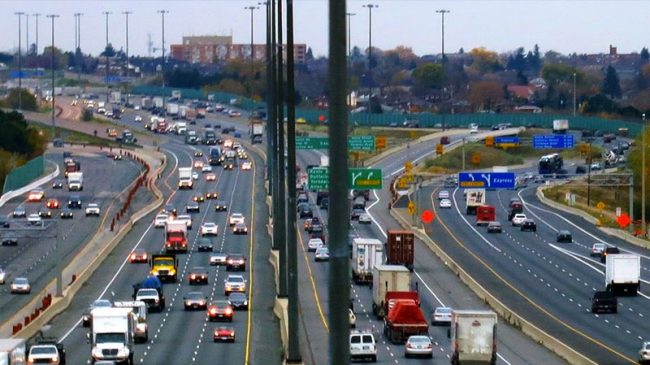While the idea of dedicated truck lanes (DTLs) has been floating around in transportation circles for at least 15 years, none have been built so far. An $8 billion proposal for a P3 project to add tolled truck lanes to I-81 in Virginia was defeated by all-out trucking industry opposition (to the tolling part) about a decade ago.
But in the past month, the idea has made the news in two different contexts. During a House Transportation & Infrastructure Committee hearing on trucking issues, Chairman Bill Shuster (R, PA) suggested that adding truck-only lanes to congested Interstates would help increase needed freight capacity. “We are going to see the doubling in the next 20 years or so of freight traffic, and then doubling again. So this is . . . a capacity issue that we have to face,” he said.
At about the same time, a news story hit the Atlanta Journal-Constitution headlined, “Truck Lanes for I-75 a $2 billion Gamble.” It discussed Georgia DOT’s plans to add two northbound DTLs to the 40-mile stretch of I-75 from Macon to the outskirts of Atlanta. This is part of a major truck route from the Port of Savannah, heading west on I-16 and then north on I-75. GDOT’s data show that trucks already constitute 20-25% of traffic on this stretch, and could well be 40% by 2040. Very little new right of way is needed, so the $2 billion cost is a surprisingly high $25 million per lane-mile. Thanks to a major transportation funding bill enacted last year (HB 170), GDOT has enough funds for a number of major project without using toll finance for this one. Meanwhile, Missouri DOT is still hoping to get tolling legislation enacted in order to reconstruct I-70 with the addition of two DTLs each way.
I see three reasons why interest in DTLs is increasing. First, the reality of a doubling of truck traffic over the next 20-25 years—in the face of already inadequate Interstate capacity in many long-distance corridors—is starting to sink in. And with driver shortages confronting the industry already, the idea of hauling more freight per driver increases trucking company interest in using “longer combination vehicles” (LCVs)—triples and long doubles, which are banned from most Interstates due to safety concerns over their operation in dense mixed traffic. The third reason is growing industry interest in truck platooning.
There is a fuel-savings economic case for trucks operating in closely-spaced, semi-automated platoons of three or more big-rigs, with two-way encrypted communications controlling their spacing. Trucks operating 50 to 75 feet apart (instead of today’s mandated 300 ft.) can reduce fuel use 5 to 10% thanks to reduced drag. This requires Stage 3 automation, in which the driver still controls steering but the automation controls acceleration and braking. Pilot projects are under way in several states, and several more have recently enacted legislation along these lines.
Some people naively expect truck platoons to operate routinely in mixed traffic, but I think that is as unlikely as the legalization of LCVs everywhere. Imaging a motorist trying to enter or exit an Interstate through a “wall” of several 3-to-5-truck platoons. Not gonna happen. And while large-scale platooning is probably more than a decade away, the timetable for planning, designing, financing, and constructing DTLs could easily be 10 years for projects that get conceptual approval this year.
This brings us back to the perennial question: how are we going to pay for modernizing the aging Interstate system? In the new FAST Act, passed in December, Congress authorized $4.5 billion over five years for freight-related infrastructure. Excuse me, but that is a drop in the bucket compared with the $1-2 trillion cost of replacing the 20th century Interstate system.
And I think trucking industry leaders are starting to figure this out. At the April 13 hearing where Shuster suggested DTLs, the American Trucking Associations’ chief of national advocacy, Dave Osiecki agreed that we have a truck capacity problem. “We need to figure out as a country, as an industry, and as a Congress a better way to fund our infrastructure—highway infrastructure—going forward.” This appears to be a departure from ATA’s long-standing advocacy of simply more of the same: higher gasoline and diesel taxes.
What ATA still has not acknowledged, at least in words, is that 21st-century tolling concepts are in circulation, and they depart significantly from the 20th-century practices ATA rightly disdains (such as toll roads as cash cows for governments). What P3 advocates need to be offering the trucking industry is a genuine value proposition: a 2nd-generation Interstate system that is worth paying for. That could include:
- A system rebuilt with DTLs in every corridor with, say, more than 25% truck traffic by a future horizon year;
- Heavy-duty pavement in the DTLs able to handle significantly higher gross weights;
- A value-based user fee whose sole purpose is to cover the capital, operating, and future expansion costs of that new Interstate system;
- Abolition of existing fuel taxes on the rebuilt corridors financed by the new user fees;
- Both platooning and use of doubles and triples allowed on all DTLs;
- Safe overnight parking areas at reasonable intervals along the replacement corridors;
- A single payment device usable nationwide, with a consolidated monthly invoice for an entire fleet’s user charges.
Were the FHWA and state DOTs to pursue such an agenda seriously, I find it hard to believe that the trucking industry would not take it seriously. They already agree that the status quo is not going to get them there.
Both the toll industry and the P3 industry need to start fleshing out this agenda—and start engaging their potential trucking customers.

